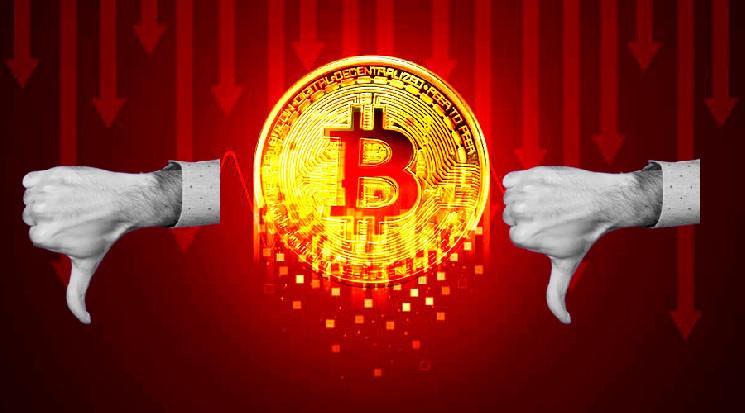Why Bitcoin Will Bloom In A Higher Inflation Environment

Disclaimer: The following op-ed represents the views of the author, and may not necessarily reflect the views of Bitcoinist. Bitcoinist is an advocate of creative and financial freedom alike.
The economic conditions that allowed Bitcoin to skyrocket from a multi-year low at $3,000 to an all-time high at $69,000 have ended. There is less liquidity across financial markets, credit has tightened, and investors are fleeing to U.S. dollars due to macroeconomic uncertainty.
Related Reading: Bitcoin ‘Rainbow Chart’ Looking At Possible $600,000 Price For BTC By October 2024
The main protagonist in the drama affecting global assets and hurting economies around the world is the U.S. Federal Reserve (Fed). The financial institution has been hiking interest rates and reducing its balance sheet with the objective of slowing down inflation.
The Fed has a mandate to keep inflation at around 2%, but for the first time since the 1970s, the measure has soared close to the 10% in the United States alone. In other parts of the world, including top economies, inflation has become a more significant issue.
Good Morning from #Germany where #inflation pressures keep rising. Import prices were 32.7% higher in Aug YoY, the highest increase since Mar 1974. Energy imports were 162.4% more expensive YoY, +18.9% MoM. The largest influence had the price increase of natural gas w/+306.3% YoY pic.twitter.com/RYMmdAfUQN
— Holger Zschaepitz (@Schuldensuehner) October 7, 2022
In the crypto space, some market participants believe that Bitcoin is going through its normal price cycle; a massive bull run followed by a bear market. However, others are speculating about the permanent impact of higher inflation as central banks steer their way out of the current situation.
What’s Bitcoin Part In The New Status Quo
In order to achieve the latter, central banks might decide on setting a higher inflation target, increasing from 2% to 4%. This weekend, the economy published a special report on this possibility titling it “The end of 2”.
Crypto investment firm Cumberland commented on the article, and its impact on Bitcoin and crypto, and the world. The main thesis behind an increase in inflation target is to provide central banks with a new tool to mitigate inflation. The firm wrote:
by revising the target upward (to 4%), central bankers can simultaneously engineer both a budgetary windfall and an off-ramp to the impending disinflationary purge/crisis/etc. n the face of daunting (at best) or even insurmountable supply-side challenges, expecting a higher inflation target now seems like a rational base case.
As a consequence, central banks might lose more credibility while they increase economic inequality for the global population. Bitcoin has been engineered to prosper in this scenario where central banks chose to protect the system rather than their population.

BTC’s price moving sideways on the 4-hour chart. Source: BTCUSDT Tradingview
Not A Hedge Against Inflation
Unlike some of the doom scenarios presented by economic experts lately, Cumberland believes that this new status quo could last for decades rather than take the world into an immediate global fallout. In this new world, people might turn to crypto, to digital assets to hedge against central banks.
By design, cryptocurrencies and digital assets are more inclusive and universally accessible, Cumberland argues. This might drive people and institutions, even governments, to adopt crypto. This happened before.
During the COVID-19 pandemic, many turn to crypto and Bitcoin to send and receive remittances, as a payment method, and as an investment tool. In many countries, it was crypto and not central banks that provide people with solutions.
As a result, the narrative “hedge against inflation” was born. This argument has been losing strength as Bitcoin is down almost 80% from its all-time high. However, Cumberland claims that crypto is not an inflation hedge.
Digital assets are a “debasement hedge”, a way to protect against central banks increasing inflation targets, and devaluating their currencies, at expense of their population. This scenario will bring central banks and lawmakers to continue pushing down on global markets to mitigate inflation.
Related Reading: India’s Central Bank RBI To Soon Launch CBDC Pilot
People will pay the price for these actions unless a “deflationary tech miracle”, the firm said, comes into the picture. The investment firm argued:
sustained, tolerated inflation is just another form of fiat currency debasement – a backdrop against which crypto performs spectacularly. If our CBs choose the former (aggressive monetary policy), a crypto summer is around the corner. If they choose the latter, look out below.






 Bitcoin
Bitcoin  Ethereum
Ethereum  Tether
Tether  USDC
USDC  TRON
TRON  Dogecoin
Dogecoin  Cardano
Cardano  Bitcoin Cash
Bitcoin Cash  Chainlink
Chainlink  LEO Token
LEO Token  Stellar
Stellar  Monero
Monero  Zcash
Zcash  Litecoin
Litecoin  Hedera
Hedera  Dai
Dai  Cronos
Cronos  OKB
OKB  Tether Gold
Tether Gold  Ethereum Classic
Ethereum Classic  KuCoin
KuCoin  Gate
Gate  Algorand
Algorand  Cosmos Hub
Cosmos Hub  VeChain
VeChain  Dash
Dash  Tezos
Tezos  Stacks
Stacks  TrueUSD
TrueUSD  IOTA
IOTA  Basic Attention
Basic Attention  Theta Network
Theta Network  Decred
Decred  NEO
NEO  Synthetix
Synthetix  Qtum
Qtum  Ravencoin
Ravencoin  0x Protocol
0x Protocol  DigiByte
DigiByte  Zilliqa
Zilliqa  Nano
Nano  Holo
Holo  Numeraire
Numeraire  Siacoin
Siacoin  Waves
Waves  Ontology
Ontology  Enjin Coin
Enjin Coin  Status
Status  BUSD
BUSD  Pax Dollar
Pax Dollar  Hive
Hive  Lisk
Lisk  Steem
Steem  Huobi
Huobi  NEM
NEM  OMG Network
OMG Network  Augur
Augur  Bitcoin Gold
Bitcoin Gold  Ren
Ren